Hampi in a nutshell
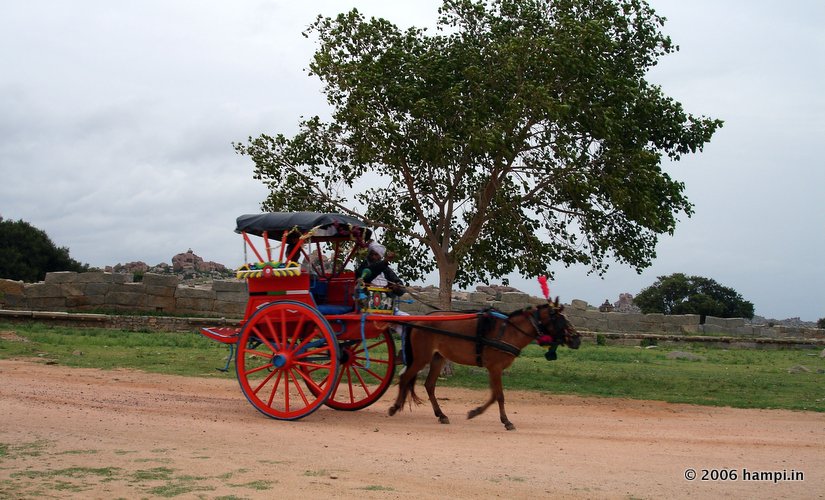
Tonga (pony cart) is a popular way to travel between the Hampi Bazaar - Royal Center - Vittala Temple route.
Tonga (pony cart) is a popular way to travel between the Hampi Bazaar - Royal Center - Vittala Temple route.
What is Hampi?
Hampi ( a.k.a Humpi or Hampe ) is both a historic & religious place in India. This was the capital of the Hindu empire,Vijayanagara, who ruled the south India during 14th to 16th century AD.
T
he ruins of Hampi, as it is known today, is a vast open museum of history, architecture and religion .Spread over an area more than 25 square kilometers (10 square miles), Hampi ruins is packed with giant temples, palaces, market streets, aquatic structures , fortifications and an abundance of other ancient monuments.
The giant boulder strewn hills and the river that bisects make a bizarre landscape for this ancient metropolis. Together with its historic and mythological residues this rural area makes a perfect tourist spot. Hampi is in the list of UNESCO’s World Heritage sites.
Where is Hampi?
Hampi is located in Karnataka state , a southwestern province of India. It's about 350 kilometers (217 miles) north of Bangalore, the state capital.
How to reach Hampi?
The primary connectivity to Hampi is by road. Rail connection comes second and the air link is a third option.
Hospet, a small town located about 12 kilometers (8 miles) from Hampi is the nearest railway station. This is the main gateway to Hampi. Hospet is connected by rail to other important towns like Bangalore, Bijapur, Hubli , Guntakal ( a major rail junction) , Hyderabad and Vasco Da Gama (Goa). Train is a preferred mode
Hospet has a bus station too with frequent bus services to the above mentioned places. The local bus service to Hampi starts from here.
The nearest airport to Hampi is Bellary (60km/ 37miles) and Hubli (170km/106miles). Other airports are Belgaum (190 km/188 miles) and Bangalore (350 km/ 217 miles). Flight connectivity varies depends on the destinations.
The typical access strategy to Hampi is simple (well, the standard Indian disclaimers apply!).
Get 'airdropped' in India, that's if you are not from India.
Reach the nearest major town or city close to Hampi. 'Close' means it could be a place anywhere from 100 to 300 kilometers (about 60 to 200 miles) away from Hampi.
These places are in general connected with the rest of the Indian cities by rail, air and road. A few examples are Bangalore, Hyderabad, Goa and Hubli, that can be labeled as the near major cities to Hampi . Travel onward to Hampi by road or train.
Hospet, the gateway town to Hampi, can be reached by bus, car or by train. Typically it's an overnight journey from Bangalore, Hyderabad or Goa.
From Hospet catch the local bus or hire a taxi/auto-rickshaw, in about 30 minutes you would be dropped at the centre of Hampi.
Follow the reverse path to get out of Hampi.
Some more tips , especially access to Hampi by train is given in this page : How to reach Hampi
What to see at Hampi?
Hampi's attractions are scattered over a large area (about 26 Sq km).You can easily count over 100 monuments in Hampi.... Some of the major one are listed here.
Vittala Temple : This temple complex dedicated to Vittala, a form of the Hindu god Vishnu is an architectural highlight of Hampi.
This temple campus contains many halls and shrines. The halls are noted for its extraordinary pillars with the animated carvings on it. A set of pillars, known as ‘musical pillars,’ resonates when tapped. A huge stone chariot complete with wheels carved out of stone stands in front of the main temple. The environment of this temple is packed with numerous smaller but ornate temples and a wide chariot street of the temple. See more on
Virupaksha Temple: This temple dedicated to Lord Shiva - the Hindu god of destruction - is located at a riverbank. Virupaksha temple is believed to be one of the oldest active temples (from 7th century AD) in India. This is a place equally sought-after by the tourists and the pilgrims. The temple complex consists of the god’s sanctum, pillared halls and a series of giant entrance towers. This is one of the fine places to witness the Hindu religious functions in close proximity. See more details on Virupaksha Temple
Royal Enclosure: The seat of the erstwhile kings, this is a fortified campus. Royal enclosure is a sprawling area with the ruins of many stately structures. For example the Mahanavami Platform from where the king used to watch the annual parade of imperial majesty and military might. The area is packed with numerous palace bases, underground temple, aquatic structures and the likes. See the monuments in Royal Enclosure.
Riverside Ruins: This is the path that connects the ancient Hampi Bazaar to the Vittala temple. Numerous shrines, carved artifacts, ruins of ancient structures are scattered all around along this path. For example the 1008 and 1008 Siva lingams carved in a matrix like pattern on a sheet of boulder at the river shore. Hampi Bazar to Vittala Temple trek along the riverside is a must do in your Hampi itinerary.
Hemakuta Hill Temples: This hill is an expanse of rocky sheets with interesting undulations. A large number of pre Vijayanagara (the empire) temples of note are located in this hilltop. The highlights are the sets of triple chambered temples with its pyramid like granite roofs. This is an important mythological site in the local folklore. That explains the density of such temples on this hill. The must visit Kadalekalu Ganesha and Sasivekalu Ganesha are on the slopes of Hemakuta Hills. Nearby is the Virupaksha Temple.
Krishna Temple: This temple is dedicated to lord Krishna, one of the ten incarnations of lord Vishnu. In Hindu mythology Krishna is known for his romantic encounters and political shrewdness! This temple was actually dedicated to the lord in his infant (crawling) form. The complex consists of the main shrine, shrines of the goddesses, the chariot/market street and the temple tank. The main hall spots a series of pillars carved with mythical rampant creatures. Opposite to the temple is the ancient Krishna Bazaar with a beautiful temple tank next to it. Krishna Temple is a must visit attraction in Hampi.
Lakshmi Narasimha : This giant monolithic statue of the man-lion god is the largest icon in Hampi. Narasimha which is one of the ten avatars (incarnation) of lord Vishnu is depicted in a cross-legged (yoga) seated position. It’s believed that the original image contained his consort Lakshmi sitting on his lap. This image was partly destroyed during the enemy invasion. Currently only a hand of the goddess resting on his waist can be seen. Lakshmi Narasimha and the adjacent giant linga image, the Badavi Linga is at a short walk from the main road to Hampi village.
Queen’s bath: This structure belongs to the royal area of the capital. Probably used by the courtly ladies or the king himself, this looks like an indoor aquatic complex. A large veranda with protruding balconies all around faces the central pool. This is one of the typical example of the Indo-Islamic hybrid architecture in Hampi. Visit Queens' Bath as part of the Royal Centre tour.
Lotus Mahal:This ornate structure was probably used by the military chief as his office or the queens of the palace as a pleasure pavilion. The pavilion spots Islamic architecture style arches and the roofs and base typical of Hindu temples. This is a ticketed area. Visit Lotus Mahal, Elephant Stables and other attractions in the Zenena Enclosure as part of the Royal Center tour.
Elephant Stables: That was the shelter for the royal elephants. This long structure is made of a series of chambers with domical roofs. Each chamber is big enough to accommodate two elephants. The central hall with an elaborated tower probably was used by the ceremonial band troop.
Hazara Rama Temple : This was a private temple of the king. The temple is special with its exceptionally carved outer walls, an unusual feature in other Vijayanagara temples. The story of Ramayana (the Hindu epic) is impressively carved on all around the shrine walls like a comics strips on stone. The inner shrine contains four polished pillars with detailed carvings of godly themes.
Pattabhirama Temple:This is a sprawling temple campus dedicated to lord Rama. The pillared halls are of special note. Tall mythical beasts carved in the shape of a series of pillars.
Hampi has easily over 100 monuments you can visit. Take a look at the One day or Three Day Hampi itinerary based on how much time you have in hand for exploring Hampi.
Where to stay in Hampi?
Visitors stay at Hampi for many days. This is a norm considering the time it requires to ‘explore’ the sites. There are three or four clusters of accommodation locations.
Hospet town is the place where one can get accommodation that is rated as luxurious in Hampi’s scale. Kamalapura, a village centre close to Hampi is the second option. This is the place where the state run hotel with fair level of staying comfort is located.
Hampi village, the epicenter of backpacker tourism, is the budget type accommodation scene. In fact every other house here is a guest house. They rent out rooms within or attached to their homes.
Virupapur Gadde across the river is the den for the hippy genre.This is a place where you can rent huts, mostly located close to the riverbank
In general, gatecrash is a reputed check in style in town. But advance booking is preferred during the peak season.
You can make a decent tour of the hampi ruins in 3 to 4 days. Though it's not uncommon to see tourists do a 1 day crash tour of Hampi. Stretch it for atleast 2 days, if you can. You can also find cheap but value for money backpacker lodge type accommodation by the river side. People do stay it those for weeks ....
Culture This kingdom was located at the edges of the Muslim sultanates of the Deccan area. That brought in an unusual combination of cultures that Hampi could boast of. The evidences of these are loud in Hampi's architecture. Apart from the Hindu and Islamic traditions, Jainism was a major religion in Hampi.
Today, far from its erstwhile metropolitan status, Hampi is very much a rural place. Many villages are scattered around this area where agriculture is the prime occupation.
Though it owns the much-touted UNESCO World Heritage tag, Hampi at its heart is a humble place. This is a place where a city dweller can savor the village life at its rural best. It looks like the villagers over here don't mind a nosy-goofy tourist stray into their village. Time, it seems, forgotten to move on in this part of the world...
Take a look at the local Etiquette & customs , for those who are new to India.
How to tour Hampi?
On foot! , that’s if you want to comb all the major ruins. You can hire bicycles or mopeds to cover a wider area ,say spots located 5 kilometers(3 miles) apart.
A smart combination of bicycle/moped and on foot explorations is the optimum strategy. There is also a limited area battery operated 'Buggy' van service around the Vittala Temple area. And if you include an occasional coracle ferry crossing and a couple of hill climbs in the agenda, your route plan is deemed perfect.
The local three wheeled taxi (Autorickshaw) or car is available for hire at the site. The major ‘hotspots’ are connected by motorable road. But this doesn't cover all the highlights of Hampi (the riverside ruins, for example).
You can hire a driver-guide as a package or hire ‘spot guides’ locally at each major attraction. If you need assistance to hire a trained guide for full-day / half-day, contact the tourist info center in Hampi Bazaar near the Virupaksha Temple. Some more details about the guide fees are mentioned in the Cost & Budget page.
Exploring Hampi independently has its special charm and pleasant surprises. See 3 Day Hampi Itinerary as well as the whrilvind type one day itineary for Hampi
When to go?
The popular tourist season is October to February with the New Year holidays as the centre peak. This period is the optimum time of the year with a pleasant weather.
However Hampi’s festival calendar is spread throughout the year.
Hampi Festival (November): This is the largest festival at Hampi. Generally they are scheduled for 3 days during the first week of November. The celebrations typically packed with shows of music, dance puppet shows fireworks and a pomp procession as the grand finale showcasing the cultural richness of the place. Of late items like rock climbing, water sports and rural sports also has been included in the schedule. More on Hampi Festival ?
Purandaradasa Aradhana (January/February): This is principally a classical musical festival. The festival is held every year to commemorate the birthday of the ancient poet Purandaradasa who lived in Hampi. Musicians of national and international repute participate in the 2-3 days of concerts.
Virupaksha Car Festival (March/April): This is the largest religious festival in Hampi. The highlight is the procession along the main chariot street in Hampi. The image of the god & goddess is kept on the temple car (the giant wooden chariot) which is the centre of the procession. The festival marks the annual ritual marriage of the god & goddess.
Phalapuja Festival (December): This again is held at the Virupaksha temple to mark the ceremonial betrothal of the divine couple.
Diwali (October): Though not specific to Hampi, Diwali is celebrated in Hampi in a grand way (usually in October). Noisy nights with firecrackers are the hallmark. Hampi Bazaar area is the epicenter of the celebrations. Visit Virupaksha temple to witness some special ceremonial functions during the evening. That includes a local procession where the temple elephant too participate.
Shivaratri (February/March): This is a special festival earmarked for all Siva Temples in general. This nightlong religious offering is held at Virupaksha Temple. More>>
Climate ?
Hampi Hampi’s climate is generally dry & hot.
March to early June is the summer. Monsoon brings some wet weather that typically lasts from late June to early August. The colder period of the year is from November to February.
Irrespective of the climate, Hampi is open for visitors all round the year.
Tourist crowd (and prices too!) drops during the summer & rainy seasons. More on climate and seasons...
How much does it cost? Let's put the last line first: Hampi won't burn a hole in your wallet !
An overnight bus ticket from Goa or Bangalore to Hampi can cost you about Rs300 to Rs400 (about USD 6 to 9); a budget type guesthouse room (double) can be rented for Rs200 to Rs300 (about USD 4 to 6);
For about Rs50 (under 1 USD ) a day , you can hire a bicycle for the sightseeing trips; or for about Rs200-Rs300 (about USD 4 to 6) you can hire a moped including the fuel cost for a days roaming; In case if you chose to hire an auto-rickshaw (three can share) for local sightseeing, it can cost you anything from Rs300 to Rs600 (USD 6 to 10) depends on the coverage and time.
Admission is free to a large number of the monuments except two or three. For The Vittala Temple & Elephant Stables the entry fee is Rs250 (USD 5) for all foreign nationals. For Indian citizens (and for visitors from Afghanistan, Bangladesh, Nepal, Bhutan, Sri Lanka, Pakistan, Maldives , Thailand and Myanmar as well ) the entry fee is Rs10. The ticket is valid for both the monuments if you visit all (Vittala & Elephant Stables) the same day.
Generally still camera usage is allowed free at all the monuments. Virupaksha Temple charges Rs50 (USD 1) camera fee.
A local guide (for a single monument) would charge you about Rs50 (USD 1) for about an hour's tour.
A decent meal can cost you about Rs40 (USD 1). For about Rs200 (USD 4), you can enjoy a great dinner by the riverside.
That's it about the major cost factors one would encounter in Hampi. It's however possible to tighten this a bit. For example you may prefer to trek instead of hiring a local taxi or stay at that Rs50 (USD 1) a night hut by the riverside.
Also there are a couple of luxury places (in Hampi's standards) where you can burn more cash.
For a more detailed list of the costs see the Cost & Budget page.

Hampi on India Map
Location of Hampi in Karnataka, India
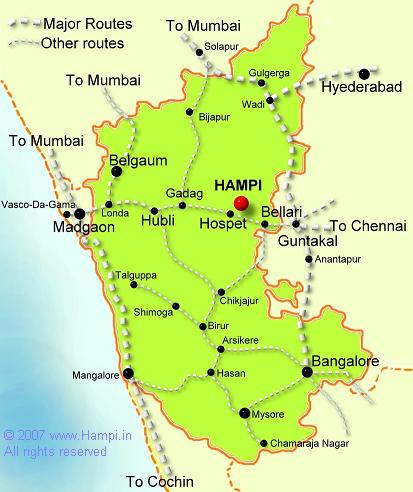
Railways Map of Karnataka
Railways map of Karnataka showing connectivity to Hampi.
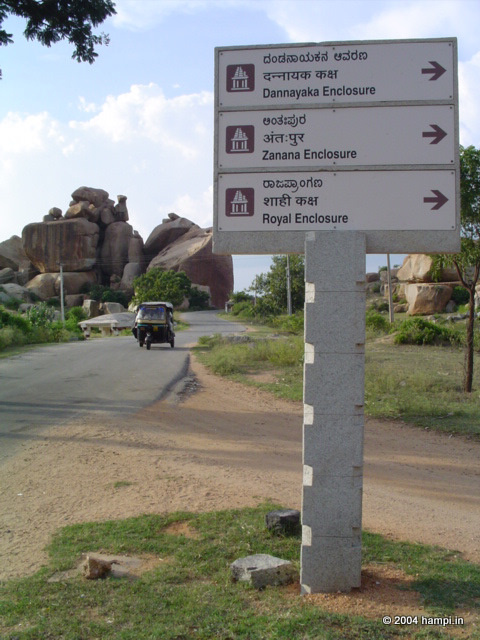
Akka Tangi Gudda by the road to Hampi
The large boulder in the background , almost projecting on to the road to Hampi is popularly called Akka Tangi Gudda, the sister boulders. The picture was taken from the deviation to the Underground Siva Temple from the Hampi main road.
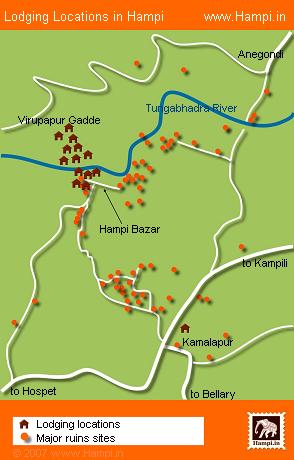
Location of Hampi lodges , hotels and guest houses.
Virupapur Gadde (also called Virupapur Gaddi or Hampi Gaddi) is the popular backpacker hideout. A large number of 'guest houses' are located close to the Virupaksha Temple. You need to cross the river for the Virupapur Gaddi area. The Guesthouses near the Virupaksha Temple are however within a walkable distance from the Hampi bus station.
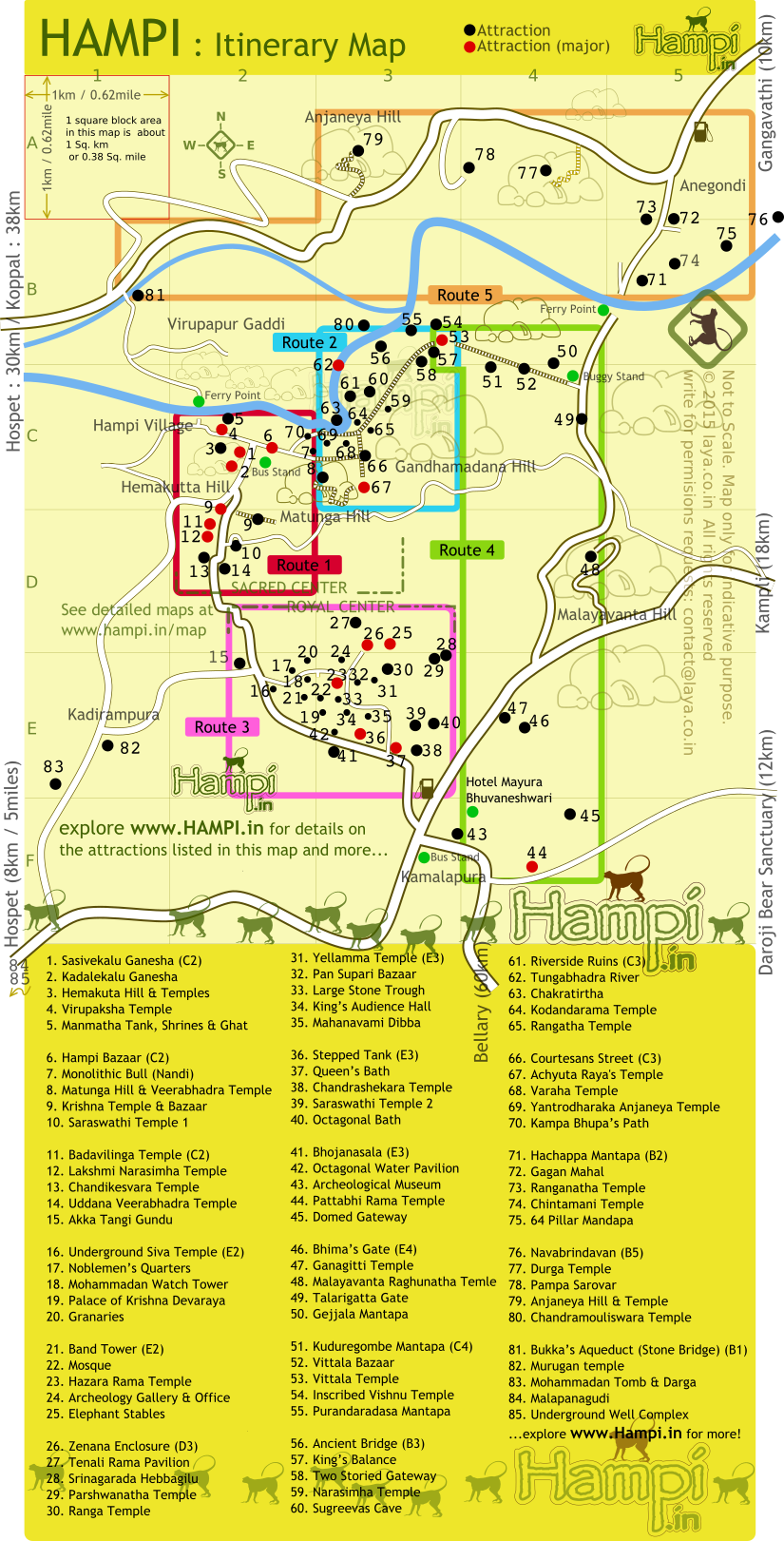 One Day Hampi Itinerary and the Three Day Hampi Itinerary. ">
One Day Hampi Itinerary and the Three Day Hampi Itinerary. ">
Hampi's attractions grouped for easy sightseeing planning.
You may want to see the One Day Hampi Itinerary and the Three Day Hampi Itinerary.

Climate chart for Hampi
Climate chart for Hampi
